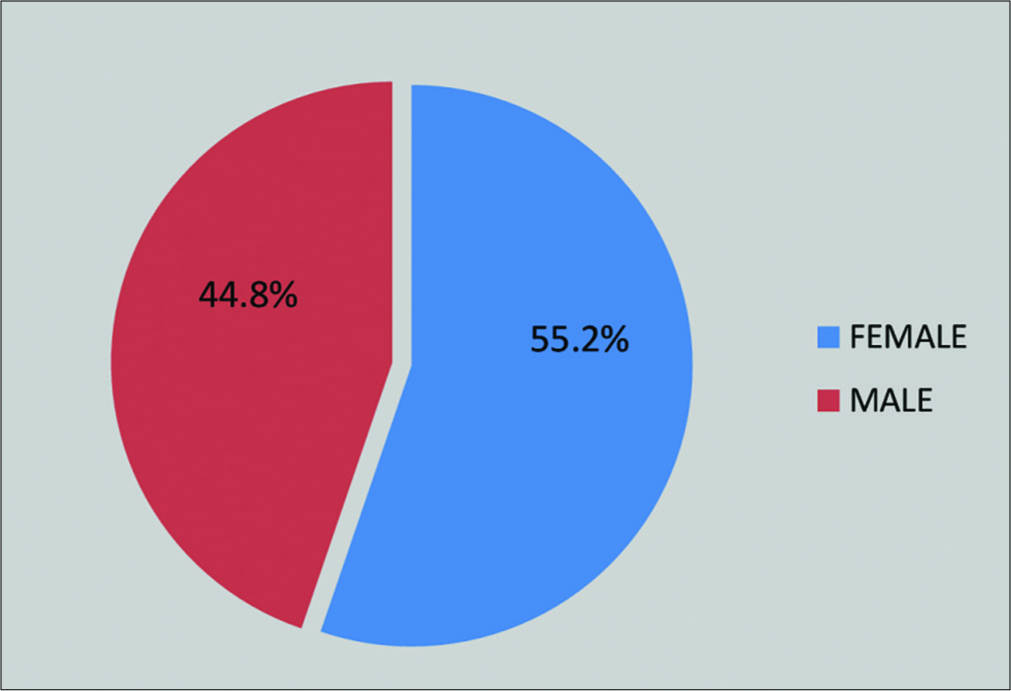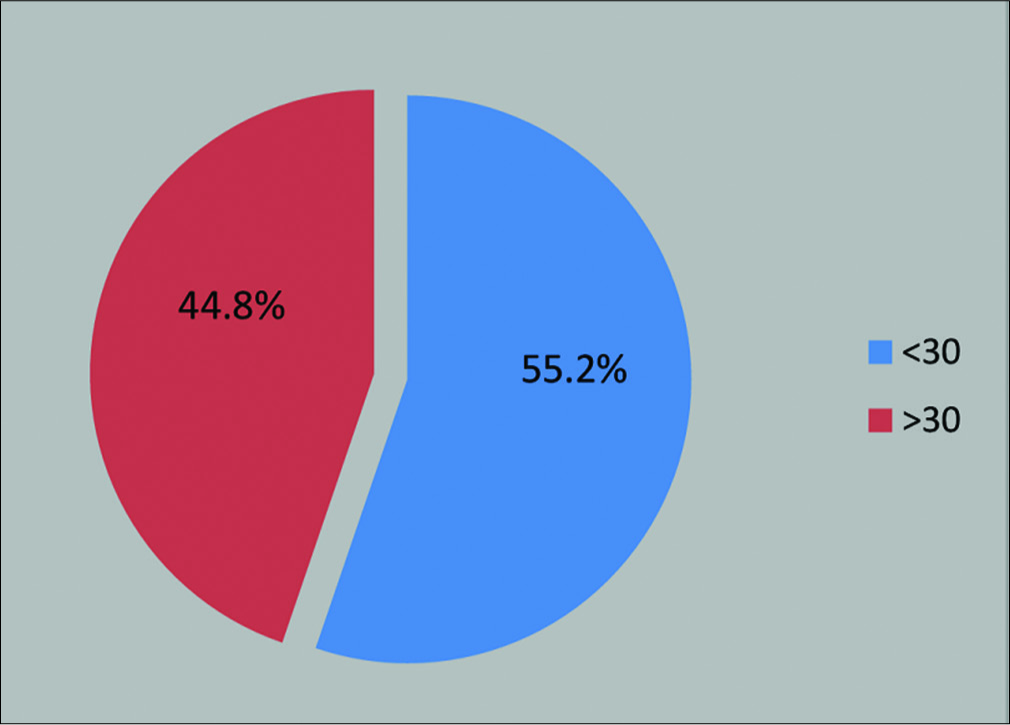Translate this page into:
Knowledge, attitude and practice towards preventive dental care- A KAP study

*Corresponding author: Dr. Tanvi Bhardwaj, Department of Public Health Dentistry, Faculty of Dental Sciences, SGT University, Gurugram, Haryana, India. tanvibhardwaj2007@yahoo.com
-
Received: ,
Accepted: ,
How to cite this article: Bhardwaj T, Tandon S, Chand S, Bhargava A. Knowledge, attitude and practice towards preventive dental care- A KAP study. J Global Oral Health 2019;2(1):36-40.
Abstract
Objective:
The aim of the study was to evaluate knowledge, attitude, and practices regarding preventive dental practice among private dental practitioners in Gurugram city.
Materials and Methods:
A descriptive cross-sectional survey was conducted using a 40-item self-administered, closed ended, and structured questionnaire. A total of 163 available private dental practitioners, from the IDA list of Gurugram city made up the sampling frame of study out of which, 105 participated. Microsoft Excel and IBM SPSS Statistics version 25.0 software were used for statistical analysis of the data collected. Statistical evaluation was done by Chi-square test and Pearson’s test.
Results:
A total of 105 dental professionals participated in this questionnaire study, 55.2% out of which were females. 88.57% dentists were generally aware of the possibility of remineralization in initial carious lesions. When there was a comparison of knowledge in relation to age distribution, mean was found to be 14.57 ± 2.569 for age <30 years and 15.85 ± 2.449 for age more than 30 years and results were found to be highly significant (P = 0.011).
Conclusions:
Majority of dentists had good knowledge and attitude regarding preventive dentistry and they were adopting preventive measures in their practice.
Keywords
Preventive dentistry
Oral
Knowledge
Attitude
Private practitioners
INTRODUCTION
Preventive dentistry may be considered to be the summation of all efforts to prevent dental diseases and disorders, or to prevent the sequelae of an individual’s dental diseases and disorders. These efforts include primary prevention which refers to any measure applied in the prepathogenic period before a preventable disease or disorder appears.[1]
Prevention at the primary level is of great value in dentistry, especially in pediatric dentistry. Since the use of preventive measures can prevent future complications, dental professionals share an important responsibility toward early screening, prompt referral, and treatment, and this knowledge must transfer into the practice of dentistry.[2]
Dental caries and periodontal disease have historically been considered the most important global health burdens. At present, the distribution and severity vary in different parts of the world and within the same country or region. Epidemiological data show that the prevalence of dental caries in most developed countries has declined in recent decades and it has been suggested that it is due to influence of multiple factors including use of fluoride, enhanced oral hygiene including brushing and flossing, dietary changes, and specific procedure performed in dentist’s office such as routine examination including diagnostic radiographs, scaling and polishing, fluoride applications, and sealants.[3]
Although the majority of oral diseases are preventable, dental services in India currently focuses primarily on the conservative management of existing diseases.[4] The World Health Organization recommended orienting dental services toward prevention and health promotion as one of priority action area for developing countries when initiating or strengthening oral health programs.[5]
Dental practitioners play a significant role in providing preventive services, educating patients, and purchasing related products; it is important to understand what they know and believe about caries prevention and how they use caries preventive measures.[6] Dentists most often look for early signs of periodontal disease, dental caries, and other changes in the soft tissue of the mouth that could lead to oral pathology.[7]
However, despite the wealth of evidence supporting the application of preventive practices in primary dental care, these practices are not fully implemented.[5] To execute a successful preventive practice, there is need of a better understanding of practice pattern that will help in targeting the continuing education by professional dental associations as well as encouraging evidence-based utilization of different preventive therapies.[2]
Therefore, this study was conducted to assess the knowledge, attitude, and practice of preventive dentistry among private dental practitioners in the Gurugram City, Haryana.
MATERIALS AND METHODS
A descriptive cross-sectional study was conducted in Gurugram city, Haryana, using a 40-item self-administered, closed-ended pre-structured questionnaire, in the month of October 2018. The questionnaire was divided into two sections, which collected the information as follows:
Section A assessed the demographic details of the respondents – gender, age, qualification, specialty, type of practice, and years of experience in the profession.
Section B was made up of 30 questions which focused on knowledge-based (20) questions regarding preventive care options, attitude-based (5) questions eliciting what the dentists feel about such strategies, and practice-based (5) questions to judge whether they incorporate these strategies in their daily practice.
All the 30 questions in Section B were closed-ended where the respondents were expected to put a tick sign against Yes/No options. The purpose of the study and the procedure to fill up the questionnaire was explained to the participants. The survey questionnaire was tested for reliability, for which, Cronbach’s alpha value came out to be 0.72. Informed consent was taken before participation in the study. Institutional Ethical Committee clearance was taken before the study. The self-completed questionnaire was distributed to 163 dentists practicing in Gurugram city, list of which was obtained from the Indian Dental Association (IDA) office of the city. Out of 163 registered dentists, 105 (64.4%) questionnaires were collected back, with two rounds of follow-ups. Questionnaire responses were tabulated using Microsoft Excel and were then analyzed using Statistical Packages for the Social Sciences (SPSS), version 25.0 software (SPSS Inc., Chicago). Results were expressed as number and percentage of respondents for each question. The test for significance to find out the association between various variables was done using Chi- square test. P ≤ 0.05 was considered statistically significant. The confidence interval was set to 95%. Pearson’s correlation test was performed to find out the correlation between knowledge, attitude, and practice mean scores.
RESULTS
The present cross-sectional self-administered questionnaire study was done on IDA registered private dental practitioners of Gurugram city, Haryana. A total of 105 private dental practitioners participated in the study. Out of all the participants, 58 (55.2%) were less than 30 years of age whereas 47 (44.8%) were more than 30 years of age [Figure 1], 58 of them were females [Figure 2]. As per qualification, 49 (46.6%) of them were BDS and 56 (53.3%) of them were MDS [Figure 3]. Out of MDS, the majority of them were periodontists and prosthodontists and only 1% of them were public health dentists [Figure 4]. About 68.6% were practicing general dentistry, 18.1% were practicing specialty, and the rest of them were practicing both [Table 1]. Figure 5 shows that most of the participants have <5 years of experience.

- Distribution of study population according to gender.

- Distribution of study participants according to age group.

- Distribution of subjects based on qualification.

- Distribution of participants according to the specialty.

- Distribution of participants according to the experience (in years).
| Characteristics | Frequency (n) | Percent (%) | Total |
|---|---|---|---|
| Gender | |||
| Females | 58 | 55.2 | 105 |
| Males | 47 | 44.8 | |
| Age ranges | |||
| <30 years old | 58 | 55.2 | 105 |
| >30 years old | 47 | 44.8 | |
| Qualification | |||
| BDS | 49 | 46.7 | 105 |
| MDS | 56 | 53.3 | |
| Practice type | |||
| General | 72 | 68.6 | 105 |
| Specific | 19 | 18.1 | |
| Mixed | 14 | 13.3 |
The mean±SD was found for knowledge as 15.14±2.585, attitude as 4.30±0.748, and practice as 4.47±0.878 [Table 2].
| Score | Mean±SD |
|---|---|
| Knowledge | 15.14±2.585 |
| Attitude | 4.30±0.748 |
| Practice | 4.47±0.878 |
Table 3 shows a comparison of mean knowledge, attitude, and practice score with age group, gender, and qualification. The mean knowledge in relation to age distribution was found to be 14.57 ± 2.569 for age <30 years and 15.85 ± 2.449 for age more than 30 years and results were found to be statistically significant (P = 0.011).
| Mean±SD | |||
|---|---|---|---|
| Knowledge | Attitude | Practice | |
| Age group | |||
| <30 years | 14.57±2.569 | 4.34±0.69 | 4.5±0.884 |
| >30 years | 15.85±2.449 | 4.26±0.82 | 4.43±0.878 |
| t-test value | 2.596 | 0.608 | 0.431 |
| P-value | 0.011* | 0.545 | 0.668 |
| Gender | |||
| Female | 15.02±2.517 | 4.36±0.718 | 4.6±0.724 |
| Male | 15.3±2.686 | 4.23±0.786 | 4.3±1.02 |
| t-test value | 0.551 | 0.871 | 1.731 |
| P-value | 0.583 | 0.386 | 0.087 |
| Qualification | |||
| BDS | 13.598±2.529 | 4.33±0.747 | 4.33±1.029 |
| MDS | 16.16±2.189 | 4.29±0.756 | 4.59±0.708 |
| t-test value | 4.738 | 0.278 | 1.504 |
| P-value | <0.001* | 0.782 | 0.136 |
Table 4 shows the correlation of mean knowledge, attitude, and practice using Pearson’s test.
| Parameters being correlated | n | Correlation (r) | P value |
|---|---|---|---|
| Attitude score and practice score | 105 | 0.074 | 0.452 |
| Knowledge score and practice score | 105 | 0.415 | <0.001* |
| Knowledge score and attitude score | 105 | 0.201 | 0.04* |
DISCUSSION
Oral health promotion and prevention are critical to reducing disease burden and increasing quality of life. Preventive dental interventions, including early and routine preventive care, fluoridation, and sealants are cost effective in reducing disease burden and associated expenditures. Prevention is the mainstay to avoid oral diseases and to have positive oral health. This aspect of dentistry is the responsibility of professionals, individuals, and society at large. Dentists are in a key position to help their patients to reduce the burden of oral disease and attain positive oral health behavior.[4]
The attitude of dental practitioners toward preventive dentistry is an important factor that can influence their decision to apply preventive dental care and may potentially affect their ability to motivate patients to receive preventive care measures.[5]
Therefore, the present study was conducted to determine the knowledge, attitude, and practices of preventive dental care among dental professionals. A total of 105 dental professionals participated in this questionnaire study, 55.2% out of which were females. The gender difference of our study participants did not appear to influence knowledge, attitude, and practice toward preventive dentistry, unlike previous research in this area in which females were more positive towards preventive dentistry than males.[8,9]
The majority of participants declared incompetence in mastering the practical skills of preventive dentistry.[5] This is in contrast to our study, where only 48.57% found it difficult to integrate preventive dental procedures in their routine dental practice.
The results of the present study reflected that 88.57% dentists were generally aware of the possibility of remineralization in initial carious lesions, which is also seen in other studies.[3] One of the reasons for increased awareness about this fact could be due to frequent reminders and promotions by a pharmaceutical company or product manufacturers’ representatives.
About 60.95% of the participants in our study acknowledge that frequency of sugars has an important role in etiology of dental caries rather than the amount which is in accordance with a study reported by Sushanth et al. (64.9%).[3]
About 91.43% of the participants counsel their patients about healthy dietary practices and 98.10% of them counsel their patients about correct brushing techniques. This is found similar to a study where 71.3% of dentists in the country always give dental health education to their patients. To motivate the rest of them, continuing education programs should be planned and implemented regularly emphasizing the importance of health education.[10]
Awareness and knowledge about tooth-friendly sugars were seen in 59 of the respondents (56.19%), which is in line with a study done by Sushanth et al. (69.1%).[3]
A study conducted on Ontario dentists[11] found a high level of knowledge but lacked awareness and positive attitude. Furthermore, pediatricians’ knowledge, attitude, and behavior were found to be unsatisfactory in a study conducted at Saudi Arabia.[12] In contrast to this finding, our study reported with a higher level of knowledge, attitude, and practice among practitioners regarding preventive dentistry. However, these results cannot be truly compared to those of the present study due to differences in the target population.
When comparing knowledge and practice in relation to qualification, it showed higher values for postgraduate practitioners as compared to undergraduates (P < 0.001) [Table 3]. Similar results were seen in a study done by Patil and Sahu.[2] This result shows the importance of training and specialization in the field.
As a whole, results indicate favorable knowledge and attitude along with good utilization of sealants, topical fluoride, and different preventive orthodontic practices. These results were found in contrast to the study by Kervanto-Seppälä[13] and a review[14] of clinical notes from 50 general dental practitioners in the United Kingdom, showing the underutilization of sealants. Similar results were seen in a study carried out by Riley[15] who reported the practice of sealants and topical fluoride as 69% and 82%, respectively.
To keep a pace with the ever changing and improving scientific knowledge in the field of dentistry, dentists must remain updated. Accurate knowledge will enable dentists to make appropriate decisions on their patients’ health.[3]
Limitations
As it is a questionnaire study, it has its own limits since most of the responses are self-reported and do not give exact information. Participant’s bias can be there as they may not reflect their true opinion and might have given socially desirable answers.
Another limitation is that it was carried out only in one city; therefore, it is recommended that such studies be carried out on a nation-wide basis to alarm the authorities in making and implementing a course of action for updating the knowledge of practicing dentists in the country.
CONCLUSIONS
It was concluded in our study that private dental practitioners in Gurugram city have good knowledge and attitude regarding preventive dentistry and most of them are including preventive dental care in their routine dental practice.
Recommendations
Our study suggests that further research would be needed to assess the outcome and impact of such interventions. Greater effort should be made by the professional organization and governmental agencies to inform patients of the benefits of preventive measures.
Acknowledgment
The authors would like to thank all the dentists who participated in the study and our Statistician, Mr. Srikant Natrajan.
Financial support and sponsorship
Nil.
Conflicts of interest
There are no conflicts of interest.
References
- A definition of preventive dentistry. J Public Health Dent. 1969;29:60.
- [CrossRef] [PubMed] [Google Scholar]
- Knowledge, attitude and practice among dental practitioners pertaining to preventive measures in paediatric patients. J Clin Diagn Res. 2016;10:ZC71-ZC75.
- [CrossRef] [PubMed] [Google Scholar]
- Assessment of knowledge, attitude, and practice regarding preventive options in oral care among dentists in Davangere city, Karnataka: A cross-sectional study. Dent Med Res. 2015;3:20-5.
- [CrossRef] [Google Scholar]
- Perceived barriers to the provision of preventive care among dentists of Udaipur, India. J Clin Exp Dent. 2015;7:e74-9.
- [CrossRef] [PubMed] [Google Scholar]
- Perceived competency towards preventive dentistry among dental graduates: The need for curriculum change. Libyan J Med. 2015;10:26666.
- [CrossRef] [Google Scholar]
- Knowledge and practices of caries prevention among Taiwanese dentists attending a national conference. J Dent Sci. 2010;5:229-36.
- [CrossRef] [Google Scholar]
- Barriers to the adoption and implementation of preventive dental services in primary medical care. Pediatrics. 2010;125:509-17.
- [CrossRef] [PubMed] [Google Scholar]
- Attitude towards preventive dentistry among Iranian senior dental students. J Dent (Tehran). 2012;9:189-95.
- [Google Scholar]
- Knowledge of and attitudes towards preventive dental care among Iranian dentists. Eur J Dent. 2007;1:222-9.
- [Google Scholar]
- Dentists' opinion and knowledge about preventive dental care in Saudi Arabia: A nationwide cross-sectional study. J Contemp Dent Pract. 2012;13:261-5.
- [CrossRef] [PubMed] [Google Scholar]
- Ontario dentists' knowledge and beliefs about selected aspects of diagnosis, prevention and restorative dentistry. J Can Dent Assoc. 1996;62:337-44.
- [Google Scholar]
- Assessment of pediatricians dental knowledge, attitude and behavior in Jeddah, Saudi Arabia. J Clin Pediatr Dent. 2011;35:371-6.
- [CrossRef] [PubMed] [Google Scholar]
- Pit and fissure sealants in dental public health-application criteria and general policy in Finland. BMC Oral Health. 2009;9:5.
- [CrossRef] [PubMed] [Google Scholar]
- The influences on preventive care provided to children who frequently attend the UK general dental service. Br Dent J. 2003;194:329-32.
- [CrossRef] [PubMed] [Google Scholar]
- Use of caries-preventive agents in children: Findings from the dental practice-based research network. Oral Health Prev Dent. 2010;8:351-9.
- [Google Scholar]






